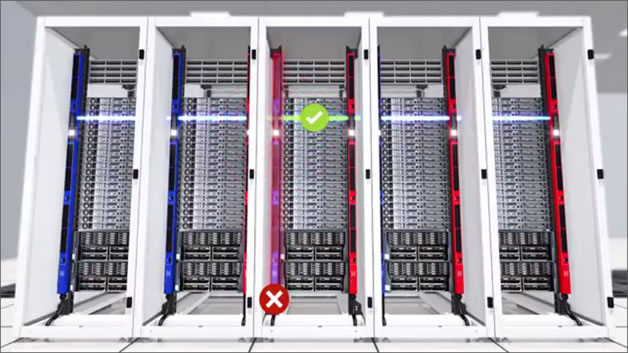The Raritan Blog
Home » Raritan Blog » iX7 Advance Controller: What is “Power Sharing”?
iX7 Advance Controller: What is “Power Sharing”?
Nicolas Sagnes
June 15, 2017

To say that it is essential to do whatever you can to avoid data center downtime is something of an understatement. According to a joint study conducted by Emerson and The Ponemon Institute, the average cost of an unplanned data center outage in the United States rose to an all-time high last year of $7,900 per minute. That's an increase of 41% from the average $5,600 cost that the same study revealed in 2010.
This is a large part of the reason why features like Power Sharing on the new iX7 controller are so important. They leverage new features of the device to provide redundant power to each controller, helping to mitigate the risks of a power loss on either power feed before they happen.
What is Power Sharing?
At the heart of the Power Sharing feature built into the new Raritan, iX7 Advance Controller is a new Expansion port, designed to provide redundant power to each connected controller in the event that an issue occurs.
In a situation where a feed power loss occurs unexpectedly, the expansion port located on the rear of the iX7 controller would bring forth a proprietary 12V power supply to the second connected controller. At the same time, it would be able to instantly send appropriate alerts to the user and user systems, both alerting those who need to know that a problem has occurred and allowing them precious seconds to do something about it.
Power Sharing is not only intended to improve general reactivity in the case of an outage, but it also goes a long way towards reducing the Mean Time To Repair (also commonly referred to as the MTTR) by providing alerts to the user right away.
Without these alerts, the user would need to notice on their own that there was an increased power draw on the second rack feed in their DCIM or BMS systems. They would have to correctly interpret that this means that one power feed was down, which isn't always necessarily going to be possible. This risks lengthy downtime until the problem is discovered, at which time only then could something be done about it.
Power Sharing in Practice
Consider the example where a user is working with standard PDU cascading using port forwarding but without Power Sharing. Because all of the PDUs in the daisy chain are communicating downstream, a power loss on the first feed would cause a ripple effect across the line - causing the user to lose all sensor readings and suffer other catastrophic issues. All power monitoring downstream from the offline PDU would cease, causing a total loss of visibility. The user would be left to discover this problem on their own without alerts.
With Power Sharing, the feature is providing redundant power to the downed controller. This doesn't just result in maintaining network connectivity, but also visibility. The user is also instantly alerted to the problem, allowing them to react much quicker than if they would have been forced to stumble upon the issue largely accidentally.
Most importantly, communication with ALL downstream devices is still maintained - and all power metering and sensor readings will continue to be reported. Only the power readings of the downed PDU would be inaccessible, as there is still a very real problem going on, but the user finally has the advanced warning and deep knowledge of the situation needed to snap into action and fix it as soon as possible. This could mean a savings of thousands or even hundreds of thousands of dollars in downtown in certain situations.
In the End
While the immediate field user alerting of Power Sharing is undoubtedly valuable, it is not the only benefit that this advanced new feature brings to the table. Superior daisy chain visibility and the ability to adequately maintain sensor reading are also hugely important. These bring with them the most important advantage of all: superior cost efficiency for organizations that can now mitigate the risks of an outage with a superior level of redundancy that wasn't available until now. To learn more watch the iX7 Advance Controller video at https://www.raritan.com/landing/most-advanced-pdu-controller-ever-built.
Other Blog Posts
- The Rapid Growth of AI and the Use of Raritan PDUs to Meet Higher Power Demands
- Posted on October 11, 2023
- Data Center Report Fewer Outages, But Downtime Still Costly
- Posted on September 20, 2023
- Survey: Energy Usage and Staffing Shortages Challenge Data Centers
- Posted on September 20, 2023
- Raritan Secure Switch: Secure NIAP 4.0 Compliant Desktop KVM
- Posted on September 20, 2023
- The Midwest is a Hot Market for Data Centers: How the New Generation of Intelligent Rack PDUs Can Save Cloud Giants Uptime and Money
- Posted on September 7, 2023
Subscribe
Upcoming Events
- Advancing Data Center Construction West 2024
- May 6 – 8 • Salt Lake City, UT
- Net Zero Data Center
- May 16 – 17 • Dallas, TX
- 7x24 Exchange Spring
- June 9th • JW Marriott Orlando Grande Lakes
Latest Raritan News
- Legrand Certifications and Process Controls Provide Confidence in Information Security for Network-Connected Devices in Data-Related Applications
- Posted on April 1, 2024
- Legrand Releases Version 4.0 of Raritan’s Industry-Leading Secure KVM Switches, Raising Bar for Secure Desktop Access
- Posted on July 31, 2023
- Legrand Revitalizes Data Center Sector with Two Revolutionary Intelligent Rack PDUs
- Posted on May 1, 2023
- Raritan Reveals The MasterConsole® Digital Dual KVM Switch
- Posted on February 18, 2021
- Legrand Data, Power and Control Division Announced as Finalist in Six Categories at DCS Awards 2020
- Posted on November 9, 2020